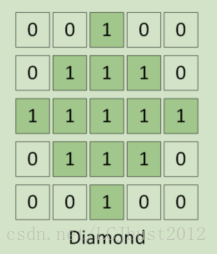论文《In Defense of Classical Image Processing: Fast Depth Completion on the CPU》提出了一种用经典的图像处理算法进行深度补全的算法,不依赖于任何训练数据,没有使用深度学习模型。
主要贡献:
1.提出了一种快速的深度补全的算法,能从稀疏的深度图中恢复完整的深度图,并且在CPU上可达到90Hz的频率。该算法的效果在KITTI depth completion benchmark中排名第一(公布时);
2.该算法的表现超越了其他现有的CNN算法。
本文提出的算法一种包含8个步骤:
(1)Depth Inversion:对于稀疏图像的处理机制是应用OpenCV的形态学操作,用较大的像素值覆盖较小的像素值。数据集KITTI raw depth map,深度值范围在0~80米之间,没有有效深度值的位置用0填充。在这种情况下,如果直接应用膨胀操作会使大距离覆盖掉小距离,从而导致较近对象的边缘信息丢失。为了解决这个问题,将有效深度做一个invert,即D(inverted) = 100.0-D(input),这样在有效深度和空值之间有一个20m的buffer。
(2)Custom Kernel Dilation(用自定义的核进行膨胀操作):先填充最接近有效像素值的空值,关键在于kernel形状的设计,要使得最可能具有相同深度值的像素被填补。因此在这一步采用的是5*5的菱形kernel,形状如下图:

(3)Small Hole Closure(对小的空洞进行闭运算):经过第一步的膨胀操作后,仍任有一些小孔,由于这些区域没有有效深度值,考虑到物体的结构,发现膨胀后相邻的深度可以连接起来形成物体的边缘。因此在这一步用





 论文《In Defense of Classical Image Processing: Fast Depth Completion on the CPU》提出了一种基于经典图像处理的快速深度补全算法,无需训练数据和深度学习模型。该算法在CPU上实现90Hz频率,效果在KITTI benchmark中领先。包括深度反转、自定义核膨胀、小孔闭运算等8个步骤,以填充稀疏深度图。然而,对于不同稀疏分布的数据,算法效果可能受限。
论文《In Defense of Classical Image Processing: Fast Depth Completion on the CPU》提出了一种基于经典图像处理的快速深度补全算法,无需训练数据和深度学习模型。该算法在CPU上实现90Hz频率,效果在KITTI benchmark中领先。包括深度反转、自定义核膨胀、小孔闭运算等8个步骤,以填充稀疏深度图。然而,对于不同稀疏分布的数据,算法效果可能受限。
 最低0.47元/天 解锁文章
最低0.47元/天 解锁文章

















 4010
4010










